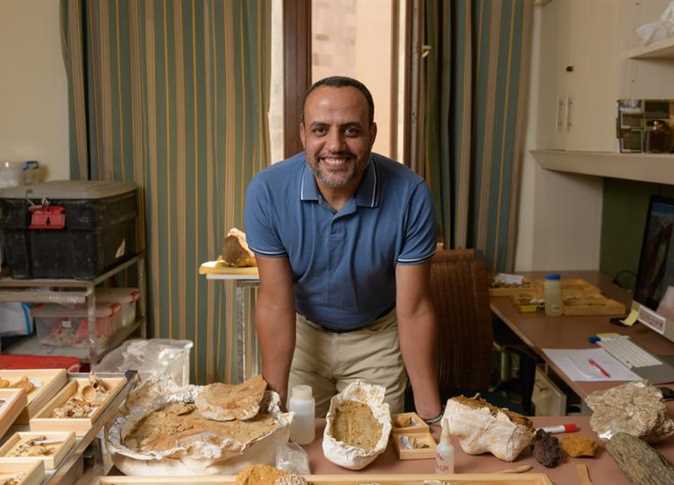
An Egyptian team of paleontologists took part in documenting the fossil of a large, carnivorous predatory dinosaur that lived 98 million years ago in the Bahariya Oasis in the Western Desert of Egypt.
The team was led by Hisham Salam, Professor of Vertebrate Paleontology at the American University in Cairo and founder of the Vertebrate Paleontology Center at Mansoura University.
The study documenting the fossil discovery was published on Thursday in the Royal Society Open Science journal.
An international team of paleontologists collaborated on the study with Bilal Salem, lead author and teaching assistant at Benha University and member of the Salam Lab team and a fellow at Ohio University.
The new fossil represents the tenth cervical vertebra of the neck of a huge carnivorous dinosaur, which was discovered in one of the joint field trips between Mansoura University’s Vertebrate Paleontology Center and scientists from the Ministry of Environment in the Bahariya Oasis in 2016.
The dinosaur belonged to a family of dinosaurs called Abelisaurus, commonly known as Abel.
The origin of the name “Abel” was in honor of Roberto Abel, the Argentine scientist who discovered the first Abelisaurus in Argentina in 1985.
“About 98 million years ago, Bahariya Oasis was not known by this name, but rather it was the “Dinosaur Oasis” in every sense of the word,” Hisham Salam, co-author of the study, said.
“It was an oasis teeming with life, in which bloody conflicts prevailed between different animals most notably were dinosaurs. The dinosaurs of that oasis lived along the banks of an ancient river known as the ‘Giant River’, where one of the largest carnivores and herbivores lived,” he continued.
“Despite the fame of the Bahariya Oasis for its rich fossil content of skeletons of the most famous dinosaurs in the world, no dinosaur belonging to the “Abel dinosaurs” has been recorded from Bahariya Oasis before.
Therefore, this study reveals important secrets about the abyssal life in the region by recording a medium-sized predatory dinosaur (estimated at about six meters long) among the rest of its family, and the medium-sized among the members of its clan of Bahariya Oasis dinosaurs,” Bilal Salem, the lead author of the study, said.
The international team, which contributed to the study, consisted of several experts including Salam; Patrick O’Connor, professor of anatomy and neuroscience at Ohio University; paleontologist Matt Lamana at the Carnegie Museum of Natural History in the US; and Sana al-Sayed, a doctoral student at the University of Michigan and deputy director of the Center for Vertebrate Paleontology at Mansoura University, along with a team from Benha University and the Egyptian Environmental Affairs Agency.
Science illustrator specializing in fossil sciences, Andrew McAfee, assisted with most of the illustrations for the research paper.
Bahariya Oasis is famous for its archaeological specimens first discovered by many exceptional dinosaurs during the early twentieth century, including the most famous of all, the largest predatory dinosaur that ever lived, Spinosaurus.
But all marine dinosaur fossils collected before World War II were destroyed during the 1944 bombing of Munich by the Allied forces in Germany.
The recent interest of researchers from the American University in Cairo and the Vertebrate Paleontology Center at Mansoura University at Mansoura University in exploring the Bahariya Oasis has contributed to restoring the area’s fossil heritage and adding additional types of rich fossils that were previously explored.
“More than two decades ago, when my collaborators and I started searching for dinosaurs in the Bahariya Oasis, we dreamed of the day when a homegrown Egyptian paleontological research group would continue our work. Thanks to Hesham, Sanaa, Belal, and others at MUVP, that day has finally come,” said Lamanna.
Thanks to Hisham, Sana, Bilal and others at the Center for Vertebrate Paleontology at Mansoura University, this dream has finally come true.
“Identifying definitive abelisaurid from Bahariya is very exciting for Egypt and MUVP, as this group of predatory dinosaurs continues to tell us a lot about vertebrate communities during the Cretaceous Period, and in particular, how Gondwanan ecosystems were assembled and maintained for a large part of Earth history during the final period of the Mesozoic Era,” O’Connor said.
Represented largely by the Carnotauris dinosaurs, the most famous of all Patagonia in the Jurassic world, the Abelisaurids had a terrifying appearance and fearsome skull and was among the most diverse and geographically widespread large predatory dinosaurs in Europe and the southern continents during the later stages of the Mesozoic or Dinosaur Age.
The new fossil of dinosaurs belonging to the “Abel” family, which has not yet been named, represents a new addition to the fossils discovered before, namely, the carnivorous dinosaurs Spinosaurus, Carcharodontosaurus and Bahariasaurus.
This fossil adds another species to the large, predatory dinosaur species that roamed what is now the Egyptian desert during the mid-Cretaceous Period.
Dinosaurs from the end of the Cretaceous Period are rare in the entire African continent, having died out shortly before the devastating asteroid impact that ended the Mesozoic 66 Era some million years ago.
However, exposed rocks laden with fossils in other oases of the Western Desert are beginning to reveal new secrets about prehistoric times.
According to Salam, scientists are starting to learn a little bit about the Bahariya Oasis dinosaurs, but there are still many secrets under the desert sands.







